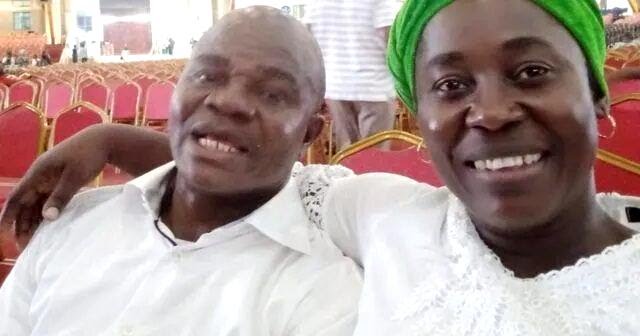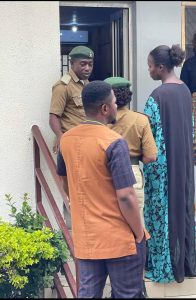Special report on Osinachi Nwachukwu case: Second day of trial
5 min read
Peter Nwachukwu and Osinachi Nwachukwu
Peter Nwachukwu overwhelmed with emotions in court
Justice Njideka Iheme of Court 56, FCT High Court, the presiding judge in the criminal trial of Peter Nwachukwu for domestic violence and death of his wife, was ready by 12pm on 21st June, 2022 to continue the trial that began the day before. Officers of the Correctional Service had brought Nwachukwu to court from the prisons, where he has been remanded.
After the case was called and the prosecution team announced appearance, the court noticed that the defense counsel was not yet in court. In a bid to assist the court, Emeka Ugwuonye, Founder of DPA, who was in court to monitor the proceedings, offered to assist the court in locating the defense counsel. The court accepted the offer. Ugwuonye stepped out of the court and was able to reach Mr. Isah A. Aliyu, the lead defense counsel, who was on his way, as he was coming from another case. This was conveyed to the court and the trial was stood down for ten minutes to allow the defense counsel to arrive.
The Nwachukwu children to testify
Trial commenced eventually by 12:20pm. The prosecution informed the court that they had one adult and two minor witnesses, and made an oral applications seeking to screen the minor witnesses from the public. Mrs. Aderonke Mana, the lead prosecutor invoked the provisions of the Child Rights Act, which is the major law that regulates children’s participation in criminal trials in Nigeria. In this instance, the prosecution was trying to use the law to protect the children of Osinachi as witnesses testifying in this case. The application was unopposed. Specially, the protection offered by law, which the prosecution was seeking to invoke, was to have the face of each child covered when testifying and to have the child screened away from everybody in the court except the judge. Also, while each child witness is testifying, nobody will be in the court room except court officials, the parents or guardian of the child and the lawyers of record.
The first two children of Osinachi and Osinachi’s twin sister were the three witnesses intended for the day. Originally, only one of the children (the first son, 12-years old) gave a statement to the police during the investigation stage, based on the proof of evidence filed by the prosecution. Adding a second child was only made known to the defense today in the prosecution’s application. Why adding the second child? The reason seems obvious. These children are going to be the best witnesses for the prosecution because they lived with their parents during the period in issue. Their testimonies will be direct and highly difficult to impeach. This should be the main worry of the defense team. Unlike other witnesses who have been relying on other sources, these children will testify as to what they saw, what they heard, what they felt. That makes them the best fact witnesses for the prosecution. The only setback is their age. They are too young.
There are many legal implications of children testifying in court, especially in criminals cases. In addition to the protective measures provided by law and which has been requested by the prosecution in this case, there are other issues such as whether a child can be trusted in his or her interpretation of facts and events and whether they are susceptible to undue influence and manipulation by interested adults who might have schooled them on what to say.
Further, the testimony of a child under fourteen years of age cannot be a sworn testimony, which has implications on the weight the court can safely accord such testimony. Because of this, the testimony of a child must be collaborated. It cannot be relied upon solely to arrive at judicial conclusions on the essential facts. This must be the reason why the prosecution felt the need to bring in also the testimony of the second child, who is 10 years old. But the challenges remain: can you collaborate the unsworn testimony of a minor with an unsworn testimony of another minor? And finally, it is a delicate process to cross-examine a child witness. The courts are known to be aggressive in protecting children from the usual blistering cross-examination or witness impeachment measures known to experienced trial lawyers. The court will bend over to protect a child witness. EculawNews believes this could be a potential point of legal fight between the prosecution and the defense lawyers later.
Osinachi’s twin sister took the stand
Amarachi Callister Madu is the 3rd witness to be called by the prosecution in the Peter Nwachukwu trial. She testified in Igbo language. She is resident in Enugu and works as a singer in a church, which she described as “Singing Ministry” job. She is 42-years old. You will recall that their elder sister, Favour Madu, had testified the day earlier, right after the testimony of their mother, Caroline, Nwachukwu. The testimony of Callister was laden with many emotional moments as she testified to her understanding of what happened and what led to the death of her sister.

As will be shown when the full testimony of Osinachi’s twin sister is analyzed, there is no doubt that the family of Osinachi believe that their brother-in-law killed their sister. However, the challenge is in showing how he did it or could have done it. Unlike the testimonies of the mother and elder sister, Callister’s testimony was more direct, more vivid and better structured, which suggests that the prosecution learned important lessons from the mistakes in the testimonies of the mother and the elder sister. Callister appeared better prepared than the witnesses before her. Nonetheless, her testimony still suffers the same problem, which is that much of it was not based on first-hand or direct information of what happened. In fact, she admitted several times that she did not know the facts. And when a witness did not witness the facts, her testimonies will be inadmissible hearsay.
This report was compiled by Eculaw News

